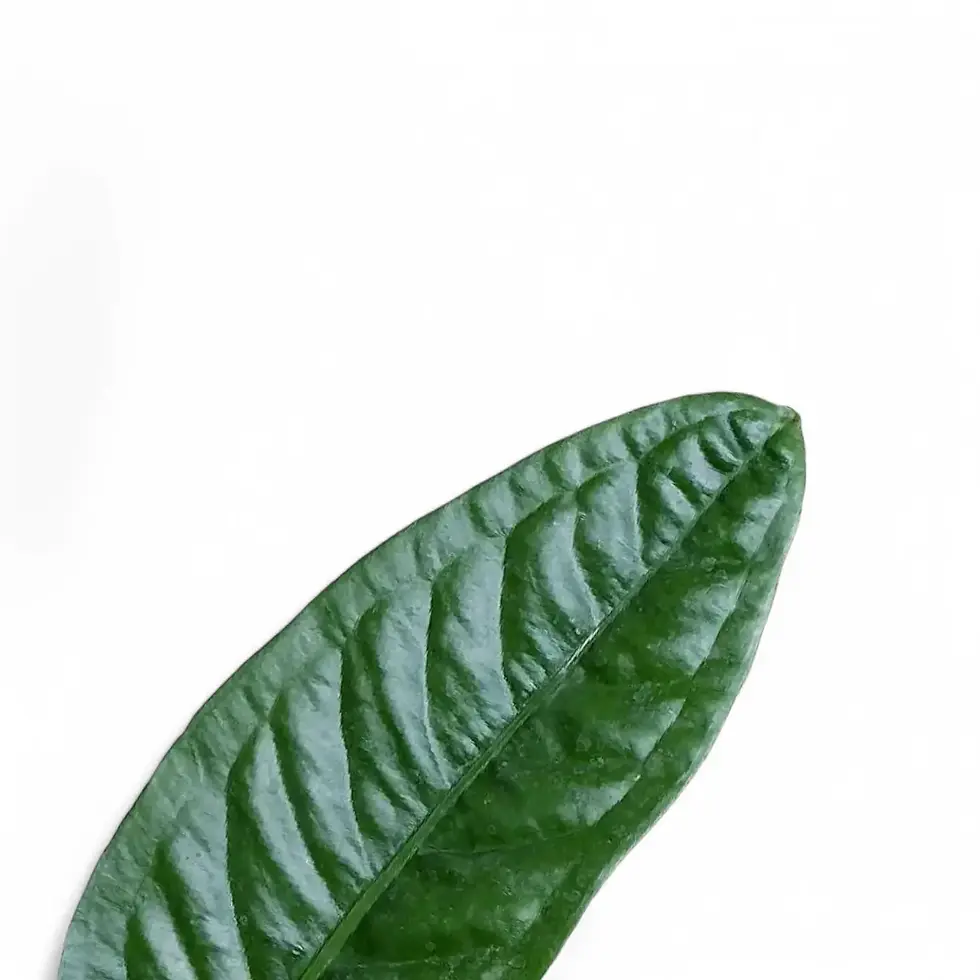Anthurium superbum – Bold Foliage in a Rosette Form
Anthurium superbum is a striking species known for its architectural rosette of upright leaves and deep green foliage with a slightly leathery, bullate surface. This bird’s nest-style Anthurium creates a dramatic silhouette, with rigid leaves forming a funnel-like structure that often collects moisture and organic debris in its center. Native to tropical lowland forests, this plant thrives in warm, humid environments and makes a bold statement indoors with minimal care.
Striking Features of Anthurium superbum
- Growth Form: Upright, rosette-forming plant with structural, symmetrical foliage
- Leaf Texture: Deep green, matte to semi-glossy with a bullate, puckered surface
- Size: Leaves can reach over 60 cm in length; overall spread can exceed 80 cm indoors
- Inflorescence: Compact, upright spadix with a modest spathe; berries may appear if pollinated
Habitat and Natural Characteristics
Anthurium superbum originates from the humid tropical forests of South America. It is typically found growing terrestrially or as a lithophyte in shaded areas with rich organic debris and high moisture. The plant’s rosette shape allows it to capture falling detritus and rainwater, creating a natural composting basin that supports growth in low-nutrient substrates.
- Native Range: Ecuador and Peru
- Indoor Height: 50–100 cm, depending on conditions
- Growth Speed: Moderate; faster in consistently humid, warm conditions
- Toxicity: Toxic to pets and humans if ingested
How to Care for Anthurium superbum
- Light: Prefers bright, filtered light or dappled shade; avoid direct sun
- Water: Water thoroughly when the top 2–3 cm of soil feels dry; ensure excellent drainage
- Humidity: Needs high humidity (60–80%) to prevent leaf curling and browning
- Temperature: Performs best between 18–27 °C; protect from drafts and cold air
- Soil: Use a chunky, well-aerated mix (e.g., orchid bark, coir, perlite)
- Repotting: Every 1–2 years or when roots crowd the container
- Fertilizing: Feed every 4–6 weeks during active growth with a balanced liquid fertilizer
- Propagation: Best done by division, separating the rosette when repotting
- Pruning: Remove old or damaged leaves to maintain form and health
Issues to Watch For
- Leaf Tip Burn: Common in low humidity or from excess fertilizer salts; flush soil and raise humidity
- Root Rot: Caused by overwatering or compact soil; ensure airy substrate and allow drying between watering
- Pests: May attract fungus gnats, mealybugs, or thrips if grown in poorly ventilated or overly wet conditions
Additional Notes for Success
Anthurium superbum’s dramatic foliage makes it a natural focal point in plant displays, especially when grown solo in a decorative pot. Its ability to collect organic debris in its central funnel in the wild helps it self-feed, so occasional top-dressing with compost or worm castings can support growth indoors. Mimicking the stable warmth, dappled light, and steady humidity of its native forest floor will yield lush, healthy growth.
Etymology
The genus name Anthurium is derived from the Greek “anthos” meaning flower and “oura” meaning tail, referring to the spadix structure. The species name “superbum” highlights its stately, commanding presence and impressive size among bird’s nest types. The species was first described by botanist Michael Madison in 1978.
Frequently Asked Questions
- Does Anthurium superbum need a humidifier indoors?
It will benefit from one, especially in dry climates or during winter when indoor air becomes dry. - Can it tolerate low light?
It can survive in lower light but will grow more slowly; for optimal growth, bright filtered light is preferred. - How often should I clean the leaves?
Wipe the leaves every few weeks with a damp cloth to remove dust and help it breathe better.
Bring the dramatic form and rich green foliage of Anthurium superbum into your collection – order now and grow a truly bold statement plant.
Anthurium superbum
Anthurium superbum comes in a ⌀ 13 cm pot and is approximately 40 cm tall
































